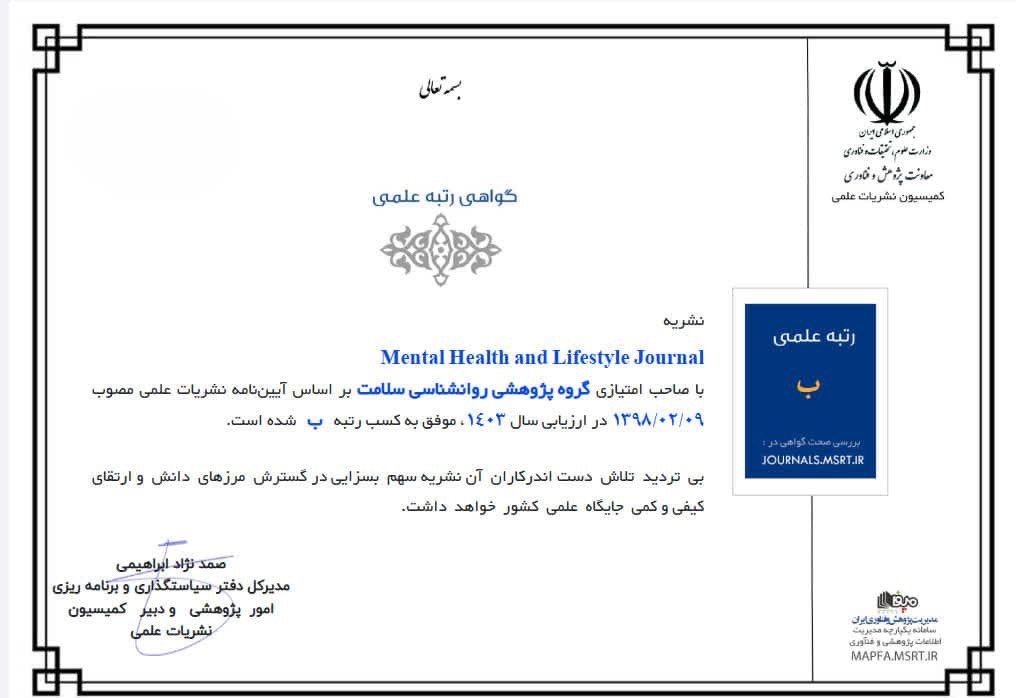Comparing the Effectiveness of Emotional Disclosure Through Drawing and Family-Based Floortime Play Therapy on Emotion Regulation Difficulties and Internalizing and Externalizing Symptoms in Children with Anxiety Symptoms
Keywords:
Emotional disclosure, Drawing therapy, Floortime play therapy, Emotion regulation, Internalizing symptoms, Externalizing symptoms, Child anxietyAbstract
This study aimed to compare the effectiveness of emotional disclosure through drawing and family-based Floortime play therapy in improving emotion regulation and reducing internalizing and externalizing symptoms in children with anxiety symptoms. This quasi-experimental study used a pretest–posttest design with a control group and follow-up. The statistical population comprised children aged 8–10 years in Qaen, South Khorasan Province, in 2024–2025. Forty-five children with anxiety symptoms, identified by scoring at least one standard deviation above the mean on the Spence Children’s Anxiety Scale–Parent version (SCAS-P), were selected through purposive sampling and randomly assigned to three groups: emotional disclosure through drawing, family-based Floortime play therapy, and control (15 participants each). Both interventions were delivered in eight 45-minute sessions held twice weekly. Data were collected using the Difficulties in Emotion Regulation Scale for Children (DERS-C) and the Child Behavior Checklist (CBCL) and analyzed with analysis of covariance (ANCOVA) and Bonferroni post hoc tests using SPSS 26. ANCOVA results indicated a significant main effect of group on emotion regulation difficulties (F = 14.926, p = .001, η² = .421), internalizing symptoms (F = 30.363, p < .001, η² = .603), and externalizing symptoms (F = 36.531, p < .001, η² = .646). Bonferroni comparisons showed both interventions were significantly more effective than the control group at posttest and follow-up (p < .001). No significant difference was observed between emotional disclosure and Floortime groups (p > .05). Both emotional disclosure through drawing and family-based Floortime play therapy effectively improved emotion regulation and reduced anxiety-related internalizing and externalizing symptoms in children, with sustained effects at follow-up, suggesting these methods as accessible and family-friendly therapeutic options.
Downloads
References
1. Zitzmann J, Rombold-George L, Rosenbach C, Renneberg B. Emotion Regulation, Parenting, and Psychopathology: A Systematic Review. Clinical Child and Family Psychology Review. 2024;27(1):1-22. doi: 10.1007/s10567-023-00452-5.
2. Rajabi G, Abbasi Q. Relationship between self-criticism, social anxiety, and fear of failure with internalized shame in students. Psychol Clin Consult Res. 2011;1(2):171-82.
3. Kwon K, Hanrahan AR, Kupzyk K. Emotional Expressivity and Emotion Regulation: Relation to Academic Functioning Among Elementary School Children. School Psychology Quarterly. 2017;32(1):75-88. doi: 10.1037/spq0000166.
4. Pouladi S, Hasanshahi MM, Rabiei M, Baghery N. The Effect of Unified Transdiagnostic Treatment on the Improvement of Internalizing Behavioral Problems, Emotional Regulation, and Empathy in Children with Anxiety Disorders. Research in Cognitive and Behavioral Sciences. 2022;12(1):141-64. doi: 10.22108/cbs.2022.133945.1655.
5. Masipour O-B. Effectiveness of Stress Inoculation Training on Emotional Regulation, Childbirth Self-Efficacy and Natural Childbirth Anxiety. Aftj. 2025;6(2):23-30. doi: 10.61838/kman.aftj.6.2.3.
6. Dragomir AM. The Dynamics of Child Anxiety as an Expression of Their Emotional Security in the Coparental System. Univers Pedagogic. 2024;83(3):85-90. doi: 10.52387/1811-5470.2024.3.13.
7. Bae S, Choi H-j. A Sequential Mediating Effects of Perfectionism, Suppression of Emotional Expression, and Parenting Stress in the Relationship Between Parentification and Housework Burnout in Women With Children. Korean Association for Learner-Centered Curriculum and Instruction. 2023;23(13):797-809. doi: 10.22251/jlcci.2023.23.13.797.
8. Hadiyan N, Mottaghi S, Rezapour-Mirsaleh Y. Investigating the Mediating Role of Maladaptive Schemas and Emotional Expression in the Relationship Between Childhood Trauma and Sexual Intimacy in Women From Low-Income Families. Aftj. 2023;4(5):610-32. doi: 10.61838/kman.aftj.4.5.35.
9. Abazari K, Malekpour M, Ghamarani A, Abedi A, Faramarzi S. Impact of Individual Differences Intervention (Floortime) Based on Parents’ Expressed Emotion on Children’s Social Skills With High-Functioning Autism Disorder. Iranian Journal of Psychiatry and Clinical Psychology. 2017;23(3):260-77. doi: 10.29252/nirp.ijpcp.23.3.260.
10. Asmeri Noubari F, Kafash Khormizi E, Tavakoli Dehghi Z, Silavi A, editors. The impact of Floortime play therapy (family-based) on enhancing children's social skills. Second Conference on Psychology, Educational Sciences, Social Sciences, and Counseling; 2023; Italy.
11. Şengül-Erdem H. DIR/Floortime: Otizm Spektrum Bozukluğunda Bir Erken Müdahale Modeli. Kalem Uluslararasi Egitim Ve Insan Bilimleri Dergisi. 2021;11(1/20):21-39. doi: 10.23863/kalem.2021.177.
12. Bayat MR. Comparison of the Effectiveness of Applied Behavior Analysis Training, Floortime-Based Play Therapy, and Their Combination in Improving Communication and Social Skills of Children with Autism Spectrum Disorders in Andimeshk: Doctoral Dissertation, Faculty of Educational Sciences and Psychology, Shahid Chamran University of Ahvaz; 2016.
13. Roghani F, Jadidi M, Peymani J. The Effectiveness of Floortime Play Therapy on Improving Executive Functions and Cognitive Emotion Regulation in Children with Attention Deficit / Hyperactivity Disorder (ADHD). International Journal of Education and Cognitive Sciences. 2022;2(4):30-44. doi: 10.22034/injoeas.2022.160686.
14. Kohansal L, editor The impact of Floortime play therapy (family-based) on enhancing children's social skills. Second Conference on Psychology, Educational Sciences, Social Sciences, and Counseling; 2021; Italy.
15. Ebadi M, Mardani‐Hamooleh M, Seyedfatemi N, Ghaljeh M, Haghani SH. Effects of Written Emotional Disclosure on the Stress of Mothers of Children With Autism. Iran Journal of Nursing. 2021;34(131):19-30. doi: 10.52547/ijn.34.131.19.
16. Bottoms BL, Peter‐Hagene LC, Epstein MA, Wiley T, Reynolds CE, Rudnicki AG. Abuse Characteristics and Individual Differences Related to Disclosing Childhood Sexual, Physical, and Emotional Abuse and Witnessed Domestic Violence. Journal of Interpersonal Violence. 2014;31(7):1308-39. doi: 10.1177/0886260514564155.
17. Liu Z, Yao C, Ying F. Effects of Digital Art Emotional Expression Therapy on the Rehabilitation of Children With Autism Spectrum Disorder. 2024. doi: 10.54941/ahfe1004556.
18. Anjam SZ, Dortaj F. Investigating the effectiveness of emotional disclosure in the form of painting on reducing aggression in female children. Journal of Advanced Pharmacy Education and Research. 2020;10(4):120-6.
19. Safikhani F. The effectiveness of grammatical mental imagery with cognitive processing on self-efficacy, emotional processing and spirituality in mothers of students with autism spectrum disorder. International Journal of Education and Cognitive Sciences. 2022;3(2):12-22. doi: 10.22034/injoeas.2022.160609.
20. Mohammadi Keshka S, Abbas SM, Abolghasemi MK. The effect of combining group play therapy with painting on internalizing and externalizing problems in children with separation anxiety disorder. Journal of Exceptional Education and Training. 2022;5(171):24-34.
Downloads
Published
Submitted
Revised
Accepted
Issue
Section
License
Copyright (c) 2025 Amir Dariush Tavasoli (Author); Samaneh Sadat Jafar Tabatabaei; Fatemeh Shahabizadeh , Maryam Nasri (Author)

This work is licensed under a Creative Commons Attribution-NonCommercial 4.0 International License.









